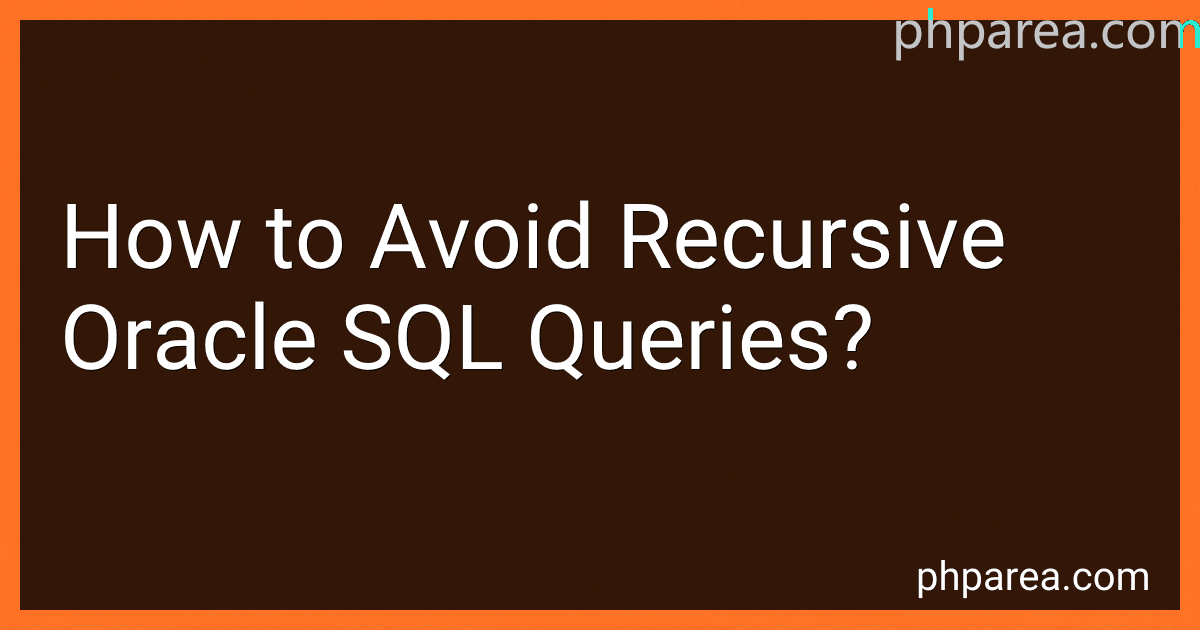Posts (page 94)
-
 8 min readMaintaining order with distinct groups in Oracle can be achieved using various techniques. Here are some commonly used methods:Using the DISTINCT keyword: The DISTINCT keyword in an SQL query allows you to retrieve only unique values from a query result. By incorporating the DISTINCT keyword along with the ORDER BY clause in your query, you can maintain order within distinct groups.
8 min readMaintaining order with distinct groups in Oracle can be achieved using various techniques. Here are some commonly used methods:Using the DISTINCT keyword: The DISTINCT keyword in an SQL query allows you to retrieve only unique values from a query result. By incorporating the DISTINCT keyword along with the ORDER BY clause in your query, you can maintain order within distinct groups.
-
 5 min readTo define a global variable in PL/SQL in Oracle, you can use the DECLARE keyword followed by the variable name, data type, and an optional initial value. Here is an example: DECLARE global_variable NUMBER := 10; -- You can replace NUMBER with any other appropriate data type -- additional global variables can be defined here BEGIN -- your PL/SQL code here END; / In the above example, global_variable is defined as a global variable of type NUMBER with an initial value of 10.
5 min readTo define a global variable in PL/SQL in Oracle, you can use the DECLARE keyword followed by the variable name, data type, and an optional initial value. Here is an example: DECLARE global_variable NUMBER := 10; -- You can replace NUMBER with any other appropriate data type -- additional global variables can be defined here BEGIN -- your PL/SQL code here END; / In the above example, global_variable is defined as a global variable of type NUMBER with an initial value of 10.
-
 9 min readRecursive Oracle SQL queries can be avoided by following certain techniques and approaches. Here are some methods to avoid recursive Oracle SQL queries:Restructuring the query: Instead of using recursive SQL, try to restructure the query using standard SQL features like joins, subqueries, or analytic functions. Analyzing the requirements and finding a different approach can often eliminate the need for recursion.
9 min readRecursive Oracle SQL queries can be avoided by following certain techniques and approaches. Here are some methods to avoid recursive Oracle SQL queries:Restructuring the query: Instead of using recursive SQL, try to restructure the query using standard SQL features like joins, subqueries, or analytic functions. Analyzing the requirements and finding a different approach can often eliminate the need for recursion.
-
 11 min readThe buffer cache in an Oracle database is a key component of Oracle's memory architecture. It is designed to enhance database performance by reducing disk I/O operations.When data is read from disk, it is stored in memory blocks, which are then cached in the buffer cache. The buffer cache is a section of the Oracle System Global Area (SGA) that holds a subset of data blocks from the database files.
11 min readThe buffer cache in an Oracle database is a key component of Oracle's memory architecture. It is designed to enhance database performance by reducing disk I/O operations.When data is read from disk, it is stored in memory blocks, which are then cached in the buffer cache. The buffer cache is a section of the Oracle System Global Area (SGA) that holds a subset of data blocks from the database files.
-
 7 min readTo find bad references in a table in Oracle, you can use the following steps:Identify the table with foreign key constraints: Determine which table contains the reference (foreign key) to another table. Let's call this table "ChildTable." Identify the referenced table: Find the table being referred to by the foreign key constraint in the "ChildTable." Let's call this table "ParentTable.
7 min readTo find bad references in a table in Oracle, you can use the following steps:Identify the table with foreign key constraints: Determine which table contains the reference (foreign key) to another table. Let's call this table "ChildTable." Identify the referenced table: Find the table being referred to by the foreign key constraint in the "ChildTable." Let's call this table "ParentTable.
-
 8 min readSpooling in Oracle refers to the process of capturing the results of a SQL query or command and saving it to a file. It allows you to generate reports, save data for further analysis, or transfer it to another system. To spool data properly in Oracle, you can follow these steps:Start by opening a SQL*Plus session on your Oracle database. Use the CONNECT command to connect to the desired database or schema.
8 min readSpooling in Oracle refers to the process of capturing the results of a SQL query or command and saving it to a file. It allows you to generate reports, save data for further analysis, or transfer it to another system. To spool data properly in Oracle, you can follow these steps:Start by opening a SQL*Plus session on your Oracle database. Use the CONNECT command to connect to the desired database or schema.
-
 5 min readTo get the end date of the last 12 months in Oracle, you can use the following query: SELECT ADD_MONTHS(TRUNC(SYSDATE, 'MM'), -ROWNUM) AS end_date FROM DUAL CONNECT BY LEVEL <= 12; This query uses the ADD_MONTHS function along with TRUNC to get the first day of the current month. By subtracting the ROWNUM from this date and repeating it for 12 times, it will generate 12 rows with the end dates of the last 12 months.
5 min readTo get the end date of the last 12 months in Oracle, you can use the following query: SELECT ADD_MONTHS(TRUNC(SYSDATE, 'MM'), -ROWNUM) AS end_date FROM DUAL CONNECT BY LEVEL <= 12; This query uses the ADD_MONTHS function along with TRUNC to get the first day of the current month. By subtracting the ROWNUM from this date and repeating it for 12 times, it will generate 12 rows with the end dates of the last 12 months.
-
 8 min readThe translate function in Oracle can also be useful for searching and identifying duplicate records in a table. The translate function allows you to replace or remove specific characters from a string. By leveraging this function, you can compare and search for duplicates by eliminating certain characters that may cause discrepancies in the comparison process.
8 min readThe translate function in Oracle can also be useful for searching and identifying duplicate records in a table. The translate function allows you to replace or remove specific characters from a string. By leveraging this function, you can compare and search for duplicates by eliminating certain characters that may cause discrepancies in the comparison process.
-
 5 min readIn PHP, you can split the input of a textarea at every line break by using the explode function.
5 min readIn PHP, you can split the input of a textarea at every line break by using the explode function.
-
 6 min readTo change a request date in PHP, you can use the built-in DateTime class and its associated methods. Here's an example of how you can achieve this:First, you'll need to capture the original request date from the user or any data source. Let's assume it is stored in a variable called $requestDate. Create a new DateTime object by passing the original request date to the constructor. This will allow you to work with the date and perform various operations on it.
6 min readTo change a request date in PHP, you can use the built-in DateTime class and its associated methods. Here's an example of how you can achieve this:First, you'll need to capture the original request date from the user or any data source. Let's assume it is stored in a variable called $requestDate. Create a new DateTime object by passing the original request date to the constructor. This will allow you to work with the date and perform various operations on it.
-
 5 min readTo change ASCII alphabet to UTF-8 in PHP, you can use the utf8_encode() function. This function takes a string as input, which is assumed to be in ISO-8859-1 encoding (which is a superset of ASCII), and converts it to UTF-8 encoding.Here's an example of how you can use it: $asciiString = "Hello World!"; $utf8String = utf8_encode($asciiString); echo $utf8String; In the example above, we have a string $asciiString that contains ASCII characters.
5 min readTo change ASCII alphabet to UTF-8 in PHP, you can use the utf8_encode() function. This function takes a string as input, which is assumed to be in ISO-8859-1 encoding (which is a superset of ASCII), and converts it to UTF-8 encoding.Here's an example of how you can use it: $asciiString = "Hello World!"; $utf8String = utf8_encode($asciiString); echo $utf8String; In the example above, we have a string $asciiString that contains ASCII characters.
-
 4 min readTo change a text in PHP, you can use several string manipulation functions which can modify the existing text. Here are some commonly used functions:str_replace: This function replaces all occurrences of a specified value with another value in a string. You can provide the string to search for, the replacement string, and the original string.Example: $text = "Hello World!"; $newText = str_replace("World", "PHP", $text); echo $newText; // Output: Hello PHP.
4 min readTo change a text in PHP, you can use several string manipulation functions which can modify the existing text. Here are some commonly used functions:str_replace: This function replaces all occurrences of a specified value with another value in a string. You can provide the string to search for, the replacement string, and the original string.Example: $text = "Hello World!"; $newText = str_replace("World", "PHP", $text); echo $newText; // Output: Hello PHP.